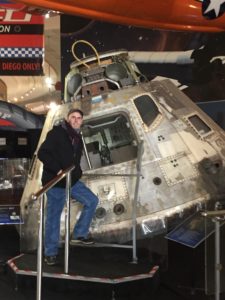Our Southern California sojourn has taken us to San Diego, where we found a rainy (!) day and were prompted to consider visiting an indoor venue.
Such as the Air and Space Museum in Balboa Park.
It was impressive enough that we were happy the day had turned rainy.
The highlight was peering through the window of the command capsule for Apollo 9, the space mission that focused on the Lunar Module — making sure the “LM” could separate from the command capsule, maneuver away from it and link up again. That ability was key to subsequent events leading to Apollo 11 and two men walking on the moon.
Also, having two men outside the command module, which was going to be a necessity when NASA reached the moon, was another “first” for Apollo 9,
I got a little verklempt peeking through the window into the tiny capsule where three crazy-brave astronauts had less personal space than a customer on the cheapest of cut-rate, sardine-can commercial airlines.
That anyone could climb into that capsule, as it sat atop a Saturn 5 rocket, waiting to be blasted into space … well, that is some cold-blooded courage, and Apollo 9 astronauts James McDivitt, David Scott and Rusty Schweikart had that “right stuff”.
Our enthusiasm for all things Apollo had been whetted by the recent movie First Man — the Ryan Gosling vehicle that explored the life and times of Neil Armstrong, the first man to step on the moon.
One of the reviews of that film made the particularly cogent point that everything pertaining to the construction of the rocket and the command capsule and the LM … well, it seemed all so fragile. To stand next to Apollo 9 is to note how small it is, and to see where the astronauts sat (for 10 days, in the case of Apollo 9’s astronauts) is astonishing.
I spent several minutes staring into the window of the Apollo 9 astronauts, and the three seats that took up most of the cramped quarters, with rows and rows of switches reachable from their seats and more information coming at them on the opposite side of the capsule.
The bottom of the command capsule, which returned to Earth, is scorched and mostly black from deflecting the tremendous heat generated by reentering Earth’ s atmosphere, keeping the command module from burning up.
Finally, Apollo 9 splashed into the Pacific Ocean, suspended by a parachute that further slowed the satellite’s descent, and were picked up by U.S. navy personnel.
A final impressive aspect of the Apollo program was how quickly it moved, especially in the three missions that included Apollos 9, 10 and 11.
Apollo 9 was launched on March 3, 1969, Apollo 10 took off on May 18 and the moon-conquering Apollo 11 took off on July 16 and two men were walking on the moon on July 21. So, yes, in only 110 days, NASA shot nine men into space, and two of them walked on the moon on that 110th day.
“One small step for man … one giant leap for mankind.”
A case can be made that after the 1960s spasm of activity, the American space program fell into a hole of limited activity it has still not escaped.
What comes next? Back to the moon? On to Mars?
Those are interesting topics, worthy of deep discussion, but it also is past time for action.
Apollo 9’s command capsule is the centerpiece of the Air and Space Museum, and it reminds us what can be accomplished when a task is made clear and those the brilliant men who can construct it and those who will travel in it can get back to work.


0 responses so far ↓
There are no comments yet...Kick things off by filling out the form below.
Leave a Comment